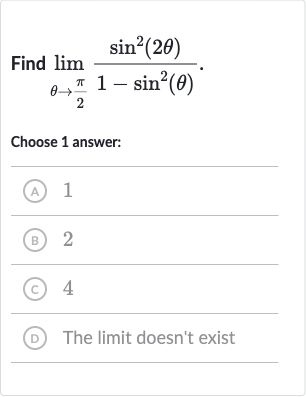Full solution
Q. Find Choose answer:(A) (B) (C) (D) The limit doesn't exist
- Recognize Limit Issue: First, let's recognize that as approaches , approaches . This means that approaches , which could lead to a division by zero issue. We need to find a way to simplify the expression to avoid this.
- Trigonometric Identity: We can use the trigonometric identity to rewrite the denominator. This gives us:
- Double Angle Formula: Next, we can use the double angle formula for sine, which is . Applying this to , we get:
- Substitute and Simplify: Substituting this back into our limit expression, we have:
- Cancel Terms: We can now cancel out the terms in the numerator and the denominator, which simplifies our expression to:
- Evaluate Limit: As approaches , approaches . Therefore, approaches , which is . So our limit becomes:
- Final Answer: The final answer is that the limit of as approaches is . Therefore, the correct choice is .

